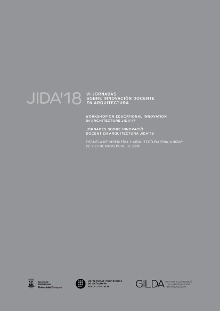Consideration of Climate Change Effects in Architectural Education
DOI:
https://doi.org/10.5821/jida.2018.5502Resumen
As the concerns for the environment and energy-efficiency (EE) emerged on the world scale, teaching in the field of anthropogenic world climate change (CC) effects became one of the key-components in contemporary educational programs. This paper presents an architectural course, based on the building physics and technology that applies two proposed techniques: climate change survey (CCS), which is founded on managing weather data (WD) and identifying CC effects, and the climate change response (CCR), which is a synthesis tool for the building performance simulation (BPS) modelling process. Regarding the pedagogical concept, the consideration should be given to the application of the proposed advanced active teaching model (AATM), which incorporates the problem-based learning (PBL), think-pair-share (TPS) and critical thinking (CT) methods. Using an active teaching approach, the aim of the course is to build among students a coherent multidisciplinary knowledge basis for use of CC analytical techniques in architectural design (AD) process.
Citas
KOLOKOTRONI, M., HEISELBERG, P. (Eds.) (2015). Ventilative Cooling. State-of-the-Art Review. IEA—EBC Programme—Annex 62 Ventilative Cooling; Aalborg, Denmark: Department of Civil Engineering, Aalborg University.
LOFTNESS, V., HAASE, D. (Eds.). (2013). Sustainable Built Environments. New York: Springer.
ALBANESE, M. A., DAST, L. C (2014). “Problem-Based Learning†in Huggett, K. N., Jeffries, W. B. (Eds.). An Introduction to Medical Teaching. Dordrecht, Heidelberg, New York, London: Springer. p. 57–68.
ALBANESE, M. A., DAST, L. C. (2013). “Problem-based learning†in Swanwick T. (Ed.). Understanding Medical Education. West Sussex: John Wiley & Sons, Ltd. p. 63–79.
AALLDÉN, S., MÄKINEN, E. (2014). “Educational Data Mining and Problem-Based Learning†in Informatics in Education, vol. 13, issue 1, p. 141–156.
ABRAMI, P. C., BERNARD, R. M., BOROKHOVSKI, E., WADDINGTON, D. I., WADE, C. A., PERSSON, T. (2015). “Strategies for Teaching Students to Think Critically†in Review of Educational Research, vol. 85, issue 2, p. 275–314.
ALLISON, J., PAN, W. (2010). “Exploring Project Based and Problem Based Learning in Environmental Building Education by Integrating Critical Thinking†in International Journal of Engineering Education, vol. 26, issue 3, p. 547–553.
ALLISON, J., PAN, W. (2011). “Implementing and Evaluating the Integration of Critical Thinking into Problem Based Learning in Environmental Building†in Journal for Education in the Built Environment, vol. 6, issue 2, p. 93–115.
EMERSON, T. L. N., ENGLISH, L., MCGOLDRICK, K. (2016). “Cooperative learning and personality types†in International Review of Economics Education, vol. 21, p. 21–29.
FITZGERALD, D. (2013). “Employing think–pair–share in associate degree nursing curriculum†in Teaching and Learning in Nursing, vol. 8, issue 3, p. 88–90.
JENTSCH, M. F., JAMES, P. A. B., BOURIKAS, L., BAHAJ, A. S. (2013). “Transforming existing weather data for worldwide locations to enable energy and building performance simulation under future climates†in Renewable Energy, vol. 55, p. 514–524.
KIRSCHNER, F., PAAS, F., KIRSCHNER, P. A. (2009). “Individual and group-based learning from complex cognitive tasks: Effects on retention and transfer efficiency†in Computers in Human Behavior, vol. 25, issue 2, p. 306–314.
KIRSCHNER, P. A., SWELLER, J., CLARK, R. E. (2006). “Why Minimal Guidance During Instruction Does Not Work: An Analysis of the Failure of Constructivist, Discovery, Problem-Based, Experiential, and Inquiry-Based Teaching†in Educational Psychologist, vol. 41, issue 2, p. 75–86.
KUHN, D., DEAN, D. (2004). “Metacognition: A Bridge Between Cognitive Psychology and Educational Practice†in Theory Into Practice, vol. 43, issue 4 , p. 268–273.
LYTH, A., DE CHASTEL, L. (2007). “Shifting towards sustainability†in Australian Planner, vol. 44, issue 3, p. 12–14.
MOORE, T. J. (2011). “Critical thinking and disciplinary thinking: a continuing debate†in Higher Education Research & Development, vol. 30, issue 3, p. 261–274.
PESIC, N., ROSET CALZADA, J., MUROS ALCOJOR, A. (2018) “Natural ventilation potential of the Mediterranean coastal region of Catalonia†in Energy and Buildings, vol. 169, p. 236–244.
PESIC, N., ROSET CALZADA, J., MUROS ALCOJOR, A. (2018) “Assessment of Advanced Natural Ventilation Space Cooling Potential across Southern European Coastal Region†in Sustainability, vol. 10, p. 3029.
ROBERTS, A. (2007). “Problem based learning in Architecture†in CEBE Briefing Guide, issue 11.
WOOD, D. F. (2003). “ABC of learning and teaching in medicine: Problem based learning†in BMJ, vol. 326, issue 7384, p. 328–330.
ZHANG, M., LUNDEBERG, M., MCCONNELL, T. J., KOEHLER, M. J., EBERHARDT, J. (2010). “Using Questioning to Facilitate Discussion of Science Teaching Problems in Teacher Professional Development†in Interdisciplinary Journal of Problem-Based Learning, vol. 4, issue 1.
HERACLES. Virtual Course: Methodologies for Climate Change impact evaluation and risk and vulnerability analysis. <http://www.heracles-project.eu/virtual-course-methodologies-climate-change-impact-evaluation-and-risk-and-vulnerability-analysis> [accessed: on 29 August 2018]
INTERGOVERNMENTAL PANEL ON CLIMATE CHANGE (IPCC). Data distribution centre. <http://www.ipcc data.org> [accessed: on 29 August 2018]
U.S. DEPARTMENT OF ENERGY’S (DOE), BUILDING TECHNOLOGIES OFFICE (BTO) (2018). EnergyPlus Weather Data. <https://energyplus.net/weather> [accessed: on 29 August 2018]
DesignBuilder Software Ltd. DesignBuilder v5.5.0.007. (9 August 2018). DesignBuilder Software Ltd. <https://www.designbuilder.co.uk> [Accessed: on 29 August 2018]
Meteotest AG. Meteonorm v7.2.4. (4 April 2018). Meteotest AG. <https://www.meteonorm.com> [Accessed: on 29 August 2018]
University of California, Los Angeles (UCLA). ClimateConsult 6.0 (Build 13). (5. July 2018). <http://www.energy-design-tools.aud.ucla.edu/climate-consultant/request-climate-consultant.php> [Accessed: on 29 August 2018]
University of Southampton. CCWorldWeatherGen v1.9. (May 2017). http://www.energy.soton.ac.uk/ccworldweathergen> [accessed: on 29 August 2018]
AMERICAN SOCIETY OF HEATING, REFRIGERATING AND AIR-CONDITIONING ENGINEERS (ASHRAE) (2017). ANSI/ASHRAE Standard 55-2017. Thermal Environmental Conditions for Human Occupancy. ANSI/ASHRAE 55-2017. Atlanta, GA, USA: American Society of Heating, Refrigerating and Air-Conditioning Engineers (ASHRAE).
COMITÉ EUROPÉEN DE NORMALISATION (CEN) (2006). CEN Standard EN15251: Indoor Environmental Input Parameters for Design and Assessment of Energy Performance of Buildings—Addressing Indoor Air Quality, Thermal Environment, Lighting and Acoustics. CEN EN15251. Brussels, Belgium: Comité Européen de Normalisation (CEN).



















